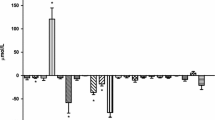Summary
For studies in physiology and biochemistry of the liver the measurement of hepatic blood flow is a fundamental precondition. Therefore, the least invasive method, the measurement of liver blood flow by indocyanine green (ICG) dye elimination, was re-evaluated for the miniature pig, an animal model of increasing interest. The accuracy of spectrophotometric determination of ICG was enhanced by addition of 5% of desoxycholic acid. It was shown that ICG was eliminated exclusively by the liver. An extraction rate of 30%–50% was found in mini-pigs, but an insufficient rate of 5%–10% in pigs of German landrace. A liver blood flow ranging from 70 to 160 ml/100g·min−1 was measured. These values are in good accordance with datas from simultaneous estimation of blood flow by133Xenon washout. As shown for a starvation/refeeding cycle, liver blood flow measurement by ICG combined with permanently implanted catheters is a practicable tool for studies of the metabolic and pharmacologic fate of substances resorbed from the gut.
Similar content being viewed by others
References
Bradley SE, Ingelfinger FJ, Bradley GT, Curry JJ (1945) The estimation of hepatic blood flow in man. J Clin Invest 24:890–897
Cherrick GR, Stein SW, Leevy CM, Davidson SC (1960) Indocyanine green: observations on its physical properties, plasma decay, and hepatic extraction. J Clin Invest 39:592–600
Cobb LA, Barnes SC (1965) Effects of reducing agents on indocyanine green dye. Am Heart J 70:145–146
Daneshmend TK, Jackson L, Roberts CJC (1981) Physiological and pharmacological variability in estimated hepatic blood flow in man. Br J Clin Pharmacol 11:491–496
Feely J, Wilkinson GR, Wood AJJ (1981) Reduction of liver blood flow and propranolol metabolism by cimetidine. N Engl J Med 304:692–695
Fox IJ, Brooker LGS, Heseltine D, Essex HE, Wood EH (1957) A tricarbocyanine dye for continuous recording of dilution curves in whole blood independent of variations in blood saturation. Proc Mayo Clin 32:478–481
Hickman R, Saunders SJ, Terblanche J (1974) Liver function in the pig. Total hepatic and portal flow values in vivo. S Afr Med J 48:1197–1200
Keiding S (1976) Hepatic elimination kinetics: the influence of hepatic blood flow on clearance determinations. Scand J Clin Lab Invest 36:113–118
Ketterer SG, Wiegand BD, Rapaport E (1960) Hepatic uptake and biliary excretion of indocyanine green and its use in estimation of hepatic blood flow in dogs. Am J Physiol 199:481–484
Krarup N, Larsen JA (1972) The effect of slight hypothermia on liver function as measured by the elimination rate of ethanol, the hepatic uptake and excretion of indocyanine green and bile formation. Acta Physiol Scand 82:396–407
Leevy CM, Mendenhall CL, Lesko W, Maseo MH (1962) Estimation of hepatic blood flow with indocyanine green. J Clin Invest 41:1169–1179
Nielsen NC (1963) Correction for blank density in spectrophotometric dye determination in turbid plasma within the spectral range 600–920 nanometers. Scand J Clin Lab Invest 15:610–612
Paschen U, Müller MJ, Seitz HJ (1982) Evaluation of133Xe washout kinetics by controlled pig liver perfusion in vivo. J Surg Res 32:586–597
Paschen U, Müller MJ (1986) Serial blood sampling from portal and hepatic vein in conscious unrestrained miniature pigs. Res Exp Med (Berl) 186:87–92
Paumgartner G, Probst P, Kraines R, Leevy CM (1970) Kinetics of indocyanine green removal from the blood. Ann NY Acad Sci 170:134–147
Polack DS, Sufian S, Matsumoto T (1979) Indocyanine green clearance in critically ill patients. Surg Gyn Obstet 149:852–854
Rowell LB, Blackmon JR, Bruce RA (1964) Indocyanine green clearance and estimated hepatic blood flow during mild to maximal exercise in upright man. J Clin Invest 43:1677–1690
Shoemaker WC, Steenburg RW, Smith LL, Moore FD (1961) Experimental evaluation of an indicator-dilution technique for estimation of hepatic blood flow. J Lab Clin Med 57:661–669
Stekiel WJ, Kampine JP, Banaszak EF, Smith JJ (1960) Hepatic clearance of indocyanine in the dog. Am J Physiol 198:881–885
Teranaka M, Schenk WG (1976) Hepatic blood flow measurement. A comparison of the indocyanine green and electromagnetic techniques in normal and abnormal flow states in the dog. Ann Surg 185:58–63
Wheeler HO, Cranston WJ, Meltzer JJ (1958) Hepatic uptake and biliary excretion of indocyanine green in the dog. Proc Soc Exp Biol NY 99:11–14
Winkler K, Tygstrup N (1960) Determination of hepatic blood flow in man by cardiogreen. Scand J Clin Lab Invest 12:353–361
Author information
Authors and Affiliations
Rights and permissions
About this article
Cite this article
Paschen, U., Müller, M.J. Liver blood flow measured by indocyanine green in conscious unrestrained miniature pigs. Res. Exp. Med. 187, 71–79 (1987). https://doi.org/10.1007/BF01854971
Received:
Accepted:
Issue Date:
DOI: https://doi.org/10.1007/BF01854971




